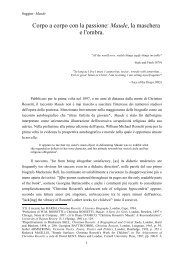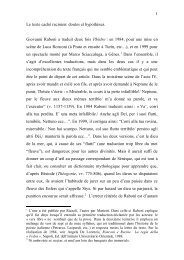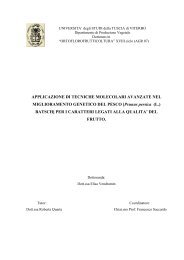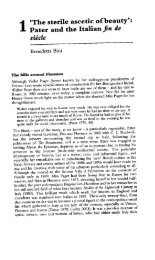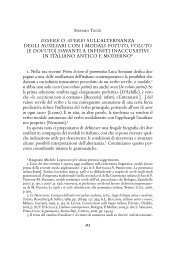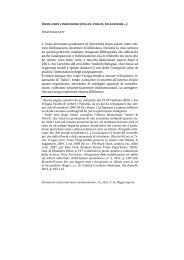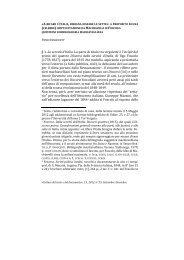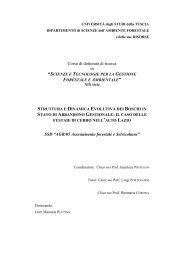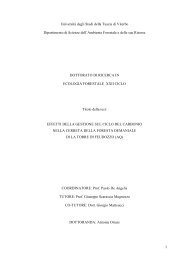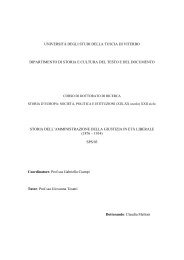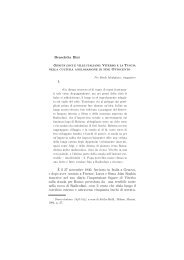drivers of soil respiration of root and microbial ... - Unitus DSpace
drivers of soil respiration of root and microbial ... - Unitus DSpace
drivers of soil respiration of root and microbial ... - Unitus DSpace
Create successful ePaper yourself
Turn your PDF publications into a flip-book with our unique Google optimized e-Paper software.
46<br />
All diurnal measurements <strong>of</strong> <strong>root</strong> <strong>and</strong> <strong>microbial</strong>-derived <strong>respiration</strong> performed in various<br />
months <strong>of</strong> 2007 were plotted together against changes in <strong>soil</strong> temperature (Fig. 7). Microbial<br />
<strong>respiration</strong> clearly increases with increase in the <strong>soil</strong> temperature: starting from November,<br />
September to June. Out <strong>of</strong> the general trend are the days <strong>of</strong> July <strong>and</strong> August with the low <strong>microbial</strong><br />
activity under the high values <strong>of</strong> temperature, this period is however characterized by a low SWC.<br />
Root-derived <strong>respiration</strong> didn’ t show such a clear dependence on seasonal changes in temperature<br />
<strong>and</strong> SWC, with relatively high values also during the driest days <strong>of</strong> July <strong>and</strong> August. However, the<br />
maximum efflux was observed as for <strong>microbial</strong> <strong>respiration</strong> in June.<br />
2.3.2. Seasonal variation <strong>of</strong> <strong>soil</strong> <strong>respiration</strong> <strong>of</strong> different origin<br />
Although we have found that the diurnal variation in <strong>soil</strong> <strong>respiration</strong> was not strongly<br />
correlated with <strong>soil</strong> temperature, increasing the time scale to seasonal level changes a picture. We<br />
assessed sensitivity <strong>of</strong> <strong>soil</strong> CO2 efflux <strong>of</strong> different origin by fitting exponential function to the data<br />
from individual treatments.<br />
Rx=aexp bTs<br />
where Rx is <strong>soil</strong> <strong>respiration</strong> from the source, Ts is a <strong>soil</strong> temperature ( o C) <strong>and</strong> a is the intercept <strong>of</strong><br />
<strong>respiration</strong> when temperature is 0 o C (basal <strong>respiration</strong> rate) <strong>and</strong> b represents temperature sensitivity<br />
<strong>of</strong> <strong>soil</strong> CO2 efflux. The b values were used to calculate a <strong>respiration</strong> quotient (Q10), which describes<br />
change in fluxes over a 10 o C in <strong>soil</strong> temperature. As the winter measurements were not possible in<br />
2006-2007, we assumed <strong>respiration</strong> rate, measured in 2008 under 0 o C <strong>soil</strong> temperature as a basal<br />
<strong>respiration</strong> <strong>and</strong> applied this value to all the other years.<br />
Q10=exp 10/b<br />
During the period with SWC>20% total <strong>and</strong> <strong>microbial</strong>-derived <strong>soil</strong> <strong>respiration</strong> were quite<br />
well correlated with seasonal changes in <strong>soil</strong> temperature at 5 cm depth (Fig. 8), increasing<br />
exponentially with increasing <strong>of</strong> Ts. The exponential relationship in the absence <strong>of</strong> the water stress<br />
accounted for approximately 82% <strong>of</strong> flux variability for Rs; 80% for Rh <strong>and</strong> 60% for Ra (Fig. 8,<br />
Table 1). The overall Q10 values for the years 2006-2007-2008 are represented in Table 1. Including<br />
in the analyses periods with lower SWC resulted in the significant decrease <strong>of</strong> the Q10’ s <strong>and</strong> loss <strong>of</strong><br />
the correlation with temperature.<br />
Root-derived <strong>respiration</strong> was less sensitive to changes in <strong>soil</strong> temperature, the correlation<br />
was not strong <strong>and</strong> under temperatures higher than 15 o C <strong>and</strong> favourable <strong>soil</strong> humidity (SWC>20%)<br />
the shape <strong>of</strong> the regression curve was reaching a plateau, without a characteristic exponential<br />
increase, observed for Rh <strong>and</strong> Rs (Fig. 8).




